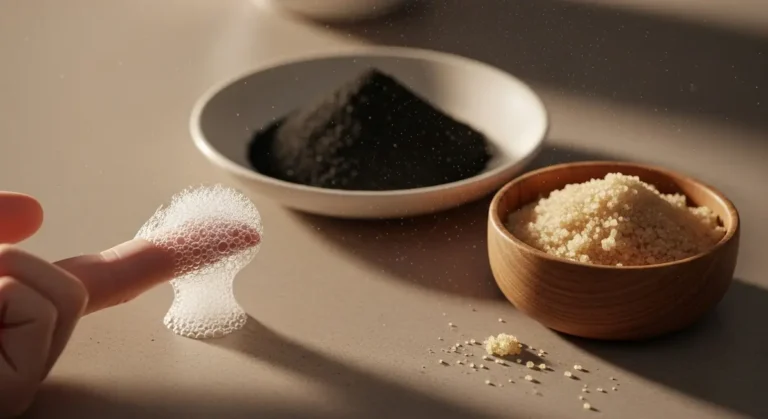Hair aging is a common, often worrying sign for adults in their 30s and beyond. This article explains why hair grays and thins, drawing on trichology and nutritional research, and offers practical, evidence-based steps to slow the process. You’ll learn which nutrients matter, how scalp health and lifestyle influence hair longevity, and when to seek professional testing or trichology care.
Hair aging: biological causes of graying and thinning

Hair undergoes two interrelated aging processes: loss of pigment and loss of bulk. Though these changes often happen together as people move through their 30s and beyond, the underlying biology is distinct. Understanding those mechanisms clarifies why some people gray early while others primarily thin, and it helps identify which changes deserve medical attention.
At the root of graying is the progressive decline of functional pigment-producing cells. Hair color depends on melanocytes within the hair follicle and their stem-cell reservoir in the follicular niche. Over time, melanocyte stem cells become depleted or lose the ability to repopulate active melanocytes, so new hairs emerge with reduced or absent melanin. Oxidative stress — from reactive oxygen species generated within the follicle and from environmental exposures — accelerates melanocyte damage. Trichology research documents accumulation of oxidative byproducts in aging follicles, and reduced antioxidant defenses correlate with earlier loss of pigment.
Thinning (reduced hair diameter and density) has different principal drivers. The dominant mechanism in common pattern hair loss (androgenetic alopecia) is follicular miniaturization: hair follicles progressively produce thinner, shorter hairs after repeated cycles. This miniaturization is hormonally mediated — androgens (notably dihydrotestosterone in genetically susceptible individuals) shorten the growth (anagen) phase and change follicle structure. Genetics set susceptibility: family history predicts earlier and more pronounced pattern thinning. Age-related changes in scalp microcirculation, extracellular matrix remodeling around follicles, and chronic low-grade inflammation also contribute to gradual loss of hair mass.
Some biological influences affect both pigment and size. Mitochondrial dysfunction and persistent oxidative stress injure both melanocytes and follicular keratinocytes, while hormonal shifts across the lifespan (e.g., menopause) alter hair cycling and can change hair texture and density. Autoimmune processes — most notably alopecia areata — attack hair follicles directly and can cause sudden, patchy hair loss and sometimes premature graying in the affected patches. Endocrine disorders, particularly thyroid dysfunction, are well-established contributors to diffuse thinning and changes in hair quality; correcting thyroid abnormalities often improves hair outcomes.
It helps to separate the visible problems clinically: graying primarily reflects pigment loss and is usually uniform or diffuse; thinning shows patterning (frontal, vertex) and reduced shaft diameter, often with a family history and gradual progression. Sudden widespread shedding (telogen effluvium), patchy alopecia, or rapidly progressive, asymmetric thinning are red flags that point away from natural chronological aging and toward medical causes.
When to seek evaluation: prompt clinical assessment is appropriate for rapid or patchy hair loss, onset of significant thinning in early adulthood, scalp symptoms (pain, intense itching, scaling), or sudden, dramatic appearance of gray hair over months. A trichologist or dermatologist will perform a focused history and scalp exam and may order targeted tests: thyroid function (TSH, free T4), ferritin and iron studies when iron deficiency is suspected, vitamin B12 and vitamin D when clinically indicated, and autoimmune screening if features suggest systemic disease. Scalp biopsy or dermoscopy can clarify scarring versus non-scarring processes when diagnosis is uncertain.
Practical perspective grounded in research: genetics largely determine the timing and pattern of both graying and pattern thinning, but modifiable factors matter. Reducing oxidative burden (sun protection for the scalp, smoking cessation), treating underlying medical contributors (thyroid disease, iron deficiency, autoimmune conditions), and addressing chronic scalp inflammation can slow or limit hair-aging effects. Evidence from trichology and nutritional studies supports evaluating and correcting clear deficiencies rather than routine high-dose supplementation for everyone.
Recognizing early signs that merit testing or specialist care empowers better outcomes. Keep an eye out for rapid change, asymmetry, scalp symptoms, and thinning that interferes with hair coverage earlier than expected for your family history. Early diagnosis — and a targeted plan that addresses hormonal, nutritional, inflammatory, and genetic factors — gives the best chance to preserve hair pigment and density as you age.
Nutrition and supplements to slow hair aging (collagen, biotin, iron and vitamins)

Maintaining hair quality as you age depends as much on what you eat as on genetics and scalp care. Hair is largely protein (keratin) and depends on a set of micronutrients to keep follicles functioning, guard pigment-producing cells, and limit inflammation and oxidative stress at the scalp. Below is a practical, evidence-focused rundown of the nutrients clinicians and trichology research most commonly link to preserving hair density, strength and color — plus how to use food and supplements sensibly.
Protein — foundational
Hair is mostly keratin protein, so sustained low protein intake can trigger telogen effluvium (widespread shedding). For adults noticing thinning, prioritize complete protein sources: eggs, poultry, lean beef, fish, dairy, soy and complementary vegetarian combinations (legumes with grains). Strength of evidence: strong for deficiency-driven hair loss; moderate for additional benefit above adequate intake. Aim for consistent daily protein; older adults or those dieting may need slightly higher intake under clinician guidance.
Iron (ferritin) — often overlooked
Iron deficiency — and low ferritin stores — is associated with diffuse hair shedding in many trichology reports. Women of reproductive age, frequent blood donors, vegetarians and people with heavy menstrual bleeding are at higher risk. Strength of evidence: moderate for an association; treatment of documented deficiency often improves shedding. Do not self-prescribe iron: excess iron is harmful. Test ferritin and a clinician-directed iron panel (CBC, ferritin, transferrin saturation) if you have unexplained shedding, fatigue or risk factors. If deficient, clinicians typically recommend oral iron therapy with follow-up blood tests.
Zinc — deficiency matters, excess harms
Zinc deficiency causes hair loss and poor regrowth; supplementation reverses this when deficiency is present. High-dose, prolonged zinc supplements can induce copper deficiency and secondary problems, so supplementation should be limited to recommended amounts (short-term correction under clinical advice). Strength of evidence: moderate for deficiency-driven benefit.
Vitamin D and B12 — check when risk is present
Low vitamin D has been observed in people with certain hair disorders (including alopecia areata and some cases of telogen effluvium), suggesting a role in follicle cycling and immune regulation. Evidence is mixed; testing and correction are reasonable when risk factors or low levels are suspected. Vitamin B12 deficiency is a less common direct cause of hair aging but can contribute to systemic ill-health that affects hair; test B12 when there are neurologic signs, macrocytic anemia, or dietary risk (strict vegetarian/vegan diets). Strength of evidence: limited to moderate; benefits primarily for those with documented deficiency.
Omega-3 fatty acids — anti-inflammatory support
EPA/DHA from oily fish and algal sources support scalp circulation and reduce inflammation. Some clinical trials report modest improvements in hair density and reduced shedding when combined with other nutrients. Strength of evidence: limited to modest; beneficial as part of an anti-inflammatory diet.
Biotin — mostly for deficiency
Biotin deficiency causes brittle nails and hair thinning, but true deficiency is rare in otherwise healthy adults. High-dose over-the-counter biotin is widely marketed for hair, but robust evidence for benefit in people without deficiency is lacking. Important safety note: high-dose biotin interferes with several lab assays (including thyroid and cardiac troponin tests), so consult your clinician before starting large doses. Strength of evidence: strong for deficiency correction; limited for general supplementation.
Collagen peptides — emerging, adjunctive
Collagen peptides deliver amino acids that may support the hair shaft and surrounding dermal matrix. Small randomized trials and cosmetic studies show modest improvements in hair thickness, tensile strength and appearance when collagen peptides are used alongside other supportive nutrients. Evidence is promising but not definitive; use as a complement to a balanced diet rather than a stand-alone cure. For practical guidance on integrating collagen into a hair-strengthening routine, consider reading a focused explainer about collagen’s role in hair structure: collagen peptides and hair strength. Strength of evidence: emerging/modest.
Practical food sources and simple swaps
- Protein: eggs, Greek yogurt, lean meats, tofu, lentils, quinoa
- Iron: red meat, liver (small portions), canned sardines, spinach (with vitamin C), beans
- Zinc: oysters, beef, pumpkin seeds, lentils
- Vitamin D: oily fish, fortified dairy/plant milks, sensible sun exposure; supplements if deficient
- B12: shellfish, red meat, dairy, fortified foods; supplements or injections when deficient
- Omega-3s: salmon, mackerel, sardines, walnuts, flaxseed (ALA) and algal oils (EPA/DHA)
- Collagen peptides: hydrolyzed collagen powders added to drinks or recipes
Safe supplement guidance
- Test before you treat: check ferritin, vitamin D and B12 when risk factors or rapid shedding are present.
- Avoid high-dose iron unless deficiency proven. Men and postmenopausal women should be cautious about routine iron supplementation. Iron absorption improves with vitamin C and is inhibited by calcium and some plant compounds.
- Limit zinc to short courses (typical supplemental ranges 15–30 mg/day) and avoid chronic high doses to prevent copper deficiency.
- Biotin supplements are generally safe at common OTC doses, but avoid very high doses without medical advice due to lab interference.
- Vitamin D maintenance doses often fall between 1,000–2,000 IU/day for many adults, but repletion dosing and monitoring should be clinician-directed.
- Collagen peptide dosing in studies generally ranges from ~2.5–10 g/day; choose reputable products and treat collagen as adjunctive nutrition rather than a magic bullet.
When to test with a clinician
Order laboratory testing when hair thinning or graying is rapid, asymmetric, accompanied by systemic symptoms (fatigue, weight change, neuropathy), or when you have risk factors (heavy menstrual bleeding, bariatric surgery, restrictive diets). Common tests: CBC, ferritin, iron studies, TSH (thyroid function), vitamin D (25-OH), B12, and where indicated, autoimmune panels. A trichologist or clinician can interpret results in context and recommend safe, targeted supplementation.
Bottom line: correct deficiencies first, prioritize a protein-rich whole-food diet and anti-inflammatory fats, use supplements judiciously, and involve a clinician when testing or higher-dose therapy is under consideration. Targeted, evidence-based nutrition supports follicle health and complements scalp care and lifestyle steps to slow hair aging.
Scalp health and lifestyle: daily habits that protect hair longevity

Healthy hair begins at the skin level. The scalp is the micro-environment that supplies follicles with oxygen, nutrients and immune signals — and it responds to the same aging forces that affect skin elsewhere: oxidative stress, chronic low-grade inflammation and reduced repair capacity. Practical daily habits that reduce oxidative damage and control inflammation preserve follicle resilience, slow visible thinning and help hair look and perform younger for longer.
Start with gentle cleansing. A balanced shampoo routine removes sebum, microbes and environmental pollutants without stripping lipids that protect the barrier. Choose mild surfactants, avoid daily harsh sulfate-based washes unless you have heavy product buildup, and use lukewarm water. When cleansing, focus on massaging the scalp with the pads of your fingers for circulation rather than aggressive scrubbing — that mechanical stimulation helps move sebum and supports local blood flow without irritating the skin.
Manage the scalp microbiome rather than sterilizing it. The scalp hosts a mix of bacteria and yeasts that normally coexist with host immunity; disruption can trigger seborrheic dermatitis, dandruff and inflammation that accelerate shedding. Use targeted medicated treatments when a clinician or trichologist diagnoses overgrowth, and favour gentle, pH-appropriate cleansers for maintenance. Avoid overusing antibacterial or antifungal washes unless directed, because indiscriminate use can create rebound imbalances.
Protect the scalp from ultraviolet (UV) damage. The scalp’s skin is thinner than much of the body, and UV exposure increases local oxidative stress that affects both epidermal cells and hair proteins. Broad-brimmed hats, physical sun protection (lightweight scarves), and daily application of scalp-safe sunscreen on exposed areas reduce cumulative photodamage. Photoprotection is as important for preserving hair fiber quality as it is for preventing skin aging.
Lifestyle factors strongly modify oxidative load and inflammation. Smoking increases oxidative stress and impairs microvascular circulation to the scalp; cessation is one of the most impactful single changes for slowing hair aging. Chronic psychological stress activates systemic inflammatory pathways and can trigger telogen effluvium (diffuse shedding); effective stress management — be it cognitive-behavioural techniques, mindfulness, or regular physical activity — reduces this risk. Prioritise consistent, restorative sleep and regular aerobic exercise: both improve systemic inflammation markers, support hormonal balance, and enhance scalp perfusion, creating a more favorable environment for follicles.
Be deliberate about topical routines and chemical services. Routine topical care that supports the barrier and reduces inflammation — gentle cleansers, lightweight emollients for dry scalps, and antioxidant-containing serums — can mitigate daily oxidative insults. Avoid frequent harsh chemical treatments (repeated bleaching, aggressive perms, overlapping relaxers) that raise local oxidative stress, damage cuticles and can injure follicles long-term. If you colour or chemically treat hair, space treatments, choose milder formulations, and use strengthening follow-up care to minimise cumulative harm.
Know when inflammation needs professional attention. Persistent redness, scaling, itching, pain, localized thinning, or sudden diffuse shedding warrant trichology or medical evaluation. A trichologist can assess scalp inflammation, recommend targeted topical or prescription therapies, manage microbiome imbalances and coordinate laboratory testing if an underlying medical condition (for example, thyroid disease or autoimmune scalp disorders) is suspected. Early intervention for chronic inflammatory scalp conditions preserves follicle health and reduces the risk of permanent miniaturization.
Practical daily checklist
- Cleanse with a gentle, pH-appropriate shampoo 1–3 times per week depending on oiliness and activity level.
- Massage the scalp with fingertips for 1–2 minutes during washing to increase circulation.
- Use photoprotection for exposed scalp (hat, sunscreen) when outdoors for extended periods.
- Avoid smoking and limit alcohol; both are linked to oxidative damage and vascular compromise.
- Prioritise sleep, stress management and moderate exercise to reduce systemic inflammation.
- Delay or moderate harsh chemical procedures; follow with protective conditioning routines.
- Consult a trichologist or clinician for persistent inflammation, rapid shedding, or patchy changes.
Scalp-focused care is not cosmetic alone — it is preventive tissue care. By reducing local oxidative stress, supporting a balanced microbiome, protecting against UV and avoiding repeated chemical trauma, you create the best possible conditions for follicles to remain active and productive. Combined with nutrition and medical assessment when indicated, these daily habits slow the visible progression of hair aging and preserve hair quality as you get older.
Conclusion
Hair aging is multifactorial but not entirely inevitable. Genetics set the baseline, yet targeted nutrition, scalp care and lifestyle changes can slow graying and thinning—and improve hair quality. Prioritize a balanced diet, check for common deficiencies, protect the scalp from inflammation and UV, and consult a trichologist or clinician for rapid or asymmetric changes. Small, consistent steps yield the best long-term results.
Want practical, research-backed tips to keep your hair youthful? Learn more about hair longevity at RelexaHub.



